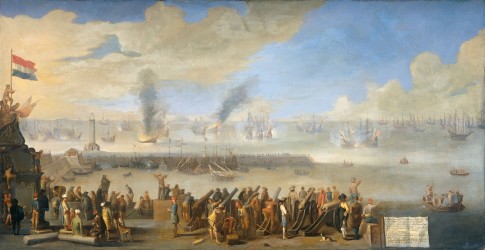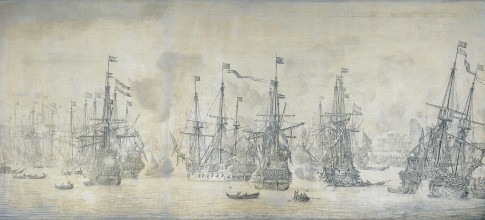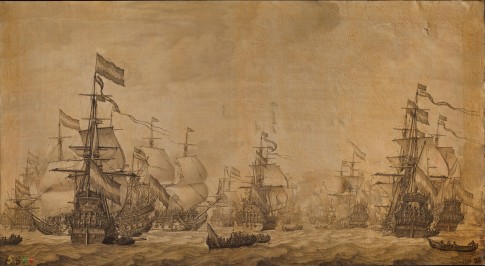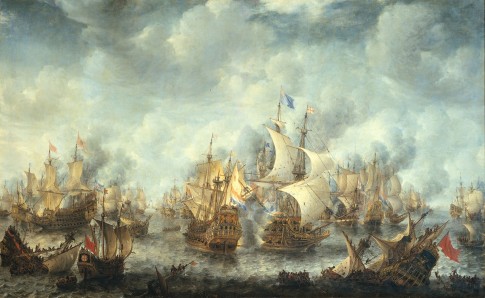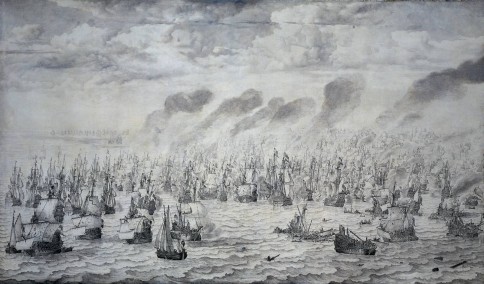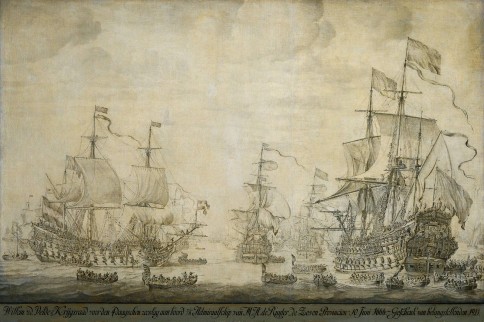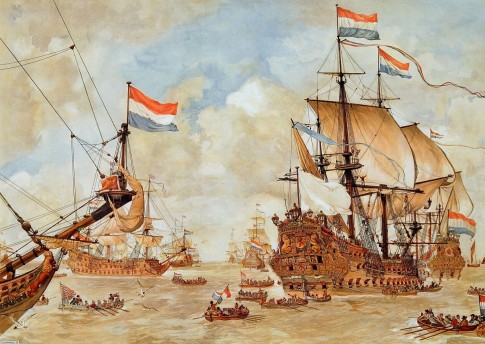In the early 1650s the damage caused by French and Barbary Coast pirates to Dutch Levant trade forced the Republic of Seven United Provinces to send an expedition commanded by Admiral Johan van Galen to the Mediterranean. With the start of the First Anglo-Dutch War the Dutch squadron had to face yet another enemy – the English ships under Captain Henry Appleton and Captain Richard Badiley.
In the first months of 1653 Dutch and English squadrons have been chasing each other in a cat and mouse game in the vicinity of the island of Elba. A series of actions resulted in a capture of an English frigate Phoenix by the Dutch. The ship was placed under the command of a young officer Cornelis Tromp, the son of the glorious Dutch Admiral Maerten Tromp.
In March 1653 the Dutch have finally succeeded in trapping Captain Appleton and his 6 ships in the port of Livorno (Leghorn) in Italy. Livorno was a neutral territory under the Grand Duke of Tuscany. On one night the English undertook a successful sortie and recaptured the Phoenix. Cornelis Tromp was surprised in his sleep but managed to escape by jumping overboard. Later he was fished out of the water by a merchantman.
This action meant a violation of the port’s neutrality by the English. Van Galen issued a demand for the English ships to leave. By this point an English squadron commanded by Richard Badiley has arrived to join forces with the trapped ships. The Dutch sailed out to face the new threat on a favorable wind. The blockaded squadron attempted to use the chance to escape and left the port. The Dutch however abandoned their previous target and instead attacked the escaping ships. All but one of Appletons ships were either destroyed or captured and only Mary could outrun the Dutch and rejoin Badiley. The wind prevented the latter from coming to Appletons rescue. At the end Badiley found himself outnumbered (8 + Mary vs. 16 Dutch) and was forced to retreat. Admiral Van Galen was mortally wounded in the action and died on March 23.
The Battle of Livorno (Leghorn) by Johannes Lingelbach, 1660
Rijksmuseum Amsterdam
These three paintings on display in the Rijksmuseum Amsterdam depict the battle from three different perspectives. The first one painted by Johannes Lingelbach allows us to see the event through the eyes of a witness from the port. The monument on the left bears an inscription in Italian: Bataglia secuita tra li vaseli olandesi e inglesi il di 14 Marzo 1653 (The battle that took place on March 14th 1653 between Dutch and English ships). At the lower right of the painting one can see a note which was obviously added later that describes the events on the painting.
The Battle of Livorno (De zeeslag bij Livorno 14 maart 1653), Reinier Nooms
Rijksmuseum Amsterdam
Amsterdam chamber for Levant trade ordered this painting from Reinier Nooms to commemorate the event that allowed the Dutch to take control over the Mediterranean. The heading of the note at the lower left reads “Sea battle off Livorno between the Dutch and English fleets under the direction of the Commanders Jan van Galen and Sir Appleton”. The painting shows us the climax of the battle: in the center we can see the boarding of the English flagship Leopard by Zon and Julius Caesar. Further to the right one can see the burning Sampson and Tromps’ Halve Maan.
Slag bij Livorno (Battle of Leghorn), Willem Van de Velde the Elder
Rijksmuseum Amsterdam
The latter two ships form the centerpiece of the next painting by Willem van de Velde the Elder. The Halve Maan is firing her guns at the Sampson, which has already been set on fire by a fire ship. In the background one can see the recaptured Phoenix, which is impossible since she was taken to Naples and was not present at the battle.
